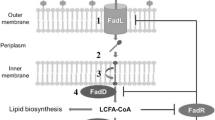Abstract
When the gene desD encoding Spirulina Δ6-desaturase was heterologously expressed in E. coli, the enzyme was expressed without the ability to function. However, when this enzyme was co-expressed with an immediate electron donor, i.e. the cytochrome b 5 domain from Mucor rouxii, the results showed the production of GLA (γ-linolenic acid), the product of the reaction catalyzed by Δ6-desaturase. The results revealed that in E. coli cells, where cytochrome b 5 is absent and ferredoxin, a natural electron donor of Δ6-desaturase, is present at a very low level, the cytochrome b 5 domain can complement for the function of ferredoxin in the host cells. In the present study, the Spirulina-ferredoxin gene was cloned and co-expressed with the Δ6-desaturase in E. coli. In comparison to the co-expression of cytochrome b 5 with the Δ6-desaturase, the co-expression with ferredoxin did not cause any differences in the GLA level. Moreover, the cultures containing the Δ6-desaturase co-expressed with cytochrome b 5 and ferredoxin were exogenously supplied with the intermediate electron donors, NADPH (nicotinamide adenine dinucleotide phosphate, reduced form) and FADH2 (flavin adenine dinucleotide, reduced form), respectively. The GLA level in these host cells increased drastically, by approximately 50%, compared to the cells without the intermediate electron donors. The data indicated that besides the level of immediate electron donors, the level of intermediate electron donors is also critical for GLA production. Therefore, if the pools of the immediate and intermediate electron donors in the cells are manipulated, the GLA production in the heterologous host will be affected.





Similar content being viewed by others
References
Cahoon E, Mills LA, Shanklin J (1996) Modification of the fatty acid composition of Escherichia coli by coexpression of a plant acyl-acyl carrier protein desaturase and feredoxin. J Bacteriol 178:936–939
Gravel P, Golaz O (1996) In: Walker JM (ed) Humana Press, New Jersy, pp 249–260
Hongsthong A, Deshnium P, Paithoonrangsarid K, Cheevadhanarak S, Tanticharoen M (2003) Differential responses of the three acyl-lipid desaturases to immediate temperature reduction occurred in two lipid membranes of Spirulina platensis strain C1. J Biosci Bioeng 96:519–524
Hongsthong A, Paithoonrangsarid K, Phapugrankul P, Sirijuntarut M, Cheevadhanarak S, Tanticharoen M (2004) The expression of three desaturase genes of Spirulina platensis in Escherichia coli DH5α. Mol Biol Reports 31:177–189
Hongsthong A, Subudhi S, Sirijuntarat M, Kurdrid P, Cheevadhanarak S, Tanticharoen M (2006) Revealing the complementation of ferredoxin by cytochrome b 5 in the Spirulina- 6-desaturation reaction by N-terminal fusion and co-expression of the fungal-cytochrome b 5 domain and Spirulina- 6-acyl-lipid desaturase. Appl Microbiol Biotechnol (in press)
Jarrett JT, Wan JT (2002) Thermal inactivation of reduced ferredoxin (flavodoxin): NADP+ oxidoreductase from Escherichia coli. FEBS Lett 529:237–242
Kurdrid P, Subudhi S, Hongsthong A, Ruengjitchatchawalya M, Tanticharoen M (2005) Functional expression of Spirulina-delta6 desaturase gene in yeast, Saccharomyces cerevisiae. Mol Biol Reports 32:215–226
Lehninger AL, Nelson DL, Cox MM (1993) Principles of Biochemistry. Worth Publisher, New York
Milton HS Jr (2000) A functional-phylogenetic classification system for transmembrane solute transporter. Microbiol. Mol Biol Rev 64:354–411
Napier J, Michaelson LV, Stobart AK (1999) Plant desaturases: harvesting the fat on land. Curr Opin Plant Biol 2:123–127
Raleigh EA, Leach K, Brent R (1986) In: Ausubel FM (ed) Wiley Interscience, New York
Sambrook J, Fritsch EF, Maniatis T (1989) Cold Spring Harbour Laboratory, Cold Spring Harbour, New York
Sato N, Murata N (1988) Membrane lipid, Meth Enzymol 167:251–259
Sperling P, Heinz E (2001) Desaturases fused to their electron donor. Eur J Lipid Sci Technol 103:158–180
Sperling P, Ternes P, Zank TK, Heinz E (2003) The evolution of desaturases. Prostaglandins Leukot Essent Fatty Acids 68:73–95
Stubbs CD, Smith AD (1984) The modification of mammalian membrane polyunsaturated fatty acid composition in relation to membrane fluidity and function. Biochimi Biophy Acta 779:89–137
Ta TD, Vickery LE (1992) Cloning, sequencing and overexpression of a [2Fe-2S] ferredoxin gene from Escherichia coli. J Biol Chem 267:11120–11125
Vollmer M, Thomsen N, Wiek S, Seeber F (2001) Apicomplexan parasites possess distinct nuclear-encoded, but apicoplast-localized, plant-type ferredoxin-NADP+ reductase and ferredoxin. J Biol Chem 276:5483–5490
Woodcock DM, Crowther PJ, Doherty J (1989) Quantitative evaluation of Escherichia coli host strain for tolerance to cytosine methylation in plasmid and phage recombinants. Nucleic Acids Res 17:3496–3478
Acknowledgements
This research was funded by a grant from the Office of the National Research Council of Thailand.
Author information
Authors and Affiliations
Corresponding author
Rights and permissions
About this article
Cite this article
Kurdrid, P., Subudhi, S., Cheevadhanarak, S. et al. Effect of two intermediate electron donors, NADPH and FADH2, on Spirulina Δ6-desaturase co-expressed with two different immediate electron donors, cytochrome b 5 and ferredoxin, in Escherichia coli . Mol Biol Rep 34, 261–266 (2007). https://doi.org/10.1007/s11033-006-9040-8
Received:
Accepted:
Published:
Issue Date:
DOI: https://doi.org/10.1007/s11033-006-9040-8



